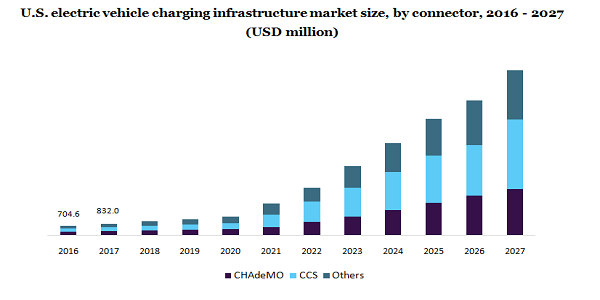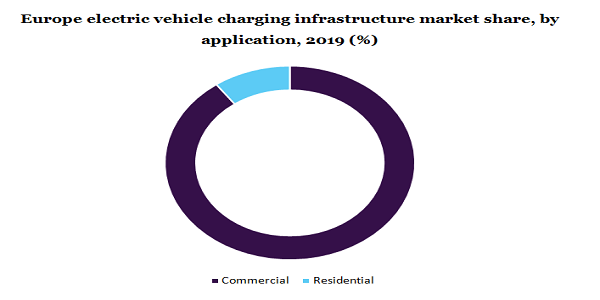- US: +1-408-610-2300
- Toll Free: +1-866-831-4085
- Become a Client
The global electric vehicle charging infrastructure market size was worth USD 11.74 billion in 2019. The market is projected to grow with a 32.0% CAGR over the forecast duration. The rise in sales of electric vehicles is the major factor attributing to the growth of the market. Further, governments across the globe are offering funds to market players to establish charging stations, which, in turn, is bolstering the market growth. For example, the California Energy Commission (CEC) offered USD 4 million to a company named ChargePoint Inc. with an aim to set up charging stations near highways in California.
Leading automotive manufacturers have upped the investment for the development of new charging points. In order to increase the adoption of electric vehicles, manufacturers are introducing new technologies like ultra-fast direct-current charging networks, autonomous park-and-charge, wireless charging, and lithium-ion batteries among others. Reduced maintenance, rising awareness about eco-friendly charging stations, and low operating expenditure are further augmenting the growth of electric vehicles, thereby, leading to the growth of the market.

Volkswagen Group is working on the development of V-Charge, an EU research project focusing on leading automotive makers such as BMW Group, General Motors, and Volkswagen are investing hugely to develop Car2X technology. This technology is anticipated to boost the adoption of electric vehicles over the next few years. For instance, Volkswagen is developing V-Charge, which is aimed to enable automation in electric vehicles for charging and parking. This technology automates the identification of parking and charging slots with the help of 3D cameras, ultrasound sensors, and digital maps along with V2X technology.
The growth of subscription-based charging models is further anticipated to drive the market growth. Various utilities like Vattenfall AB and Duke Energy Corporation offer subscription-based charging facilities. Duke Energy Corporation, in 2019, collaborated with ChargePoint Inc. to provide a charging facility for electric vehicles in North California. In addition, companies like E.ONare and Enel X are focusing on developing a Peer-to-Peer charging station. In this regard, Enel X collaborated with Innogy and developed P2P charging facilities in Germany.
However, high costs associated with installation, maintenance, and operations are projected to adversely affect the market growth. Further, underinvestment in emerging countries for the development of charging infrastructure is deterring the growth prospect. The European Environment Agency (EEA) reported that by May 2016 only 10 European countries out of a total of 28 have received an incentive to develop charging infrastructure.
By charger type, EVCI is categorized into fast and slow chargers. In 2019, the fast charger category occupied the largest market share due to the rising use of such chargers for commercial purposes. Different chargers under this segment include Tesla Superchargers, DC chargers, and AC chargers. These chargers are capable of charging electric batteries in under 30 minutes. The installation of advanced technologies including Near-field Communication (NFC) and Radio Frequency Identification (RFID) on highways is proliferating the market growth. In order to develop fast-charging stations, electric bus manufacturers are collaborating with original equipment manufacturers. For example, VDL Bus and Coach BV collaborated with Heliox with an aim to develop 100 fast chargers for buses.
On the other hand, in 2019, the slow charger category held a considerable market share. Growing emphasis on setting up public charging facilities is bolstering the segment growth. Public charging infrastructure often deploys slow chargers. The demand for electric vehicles equipped with onboard charging facilities is gaining traction. Key electric vehicle manufacturers are providing slow charging facilities with purchasing, thereby, leading to the growth of the market.
By connector, the EV charging infrastructure market is divided into Combined Charging System (CCS), CHArge de MOve (CHAdeMO), and others. Of them, in 2019, CHAdeMO held the largest market share due to their bi-directional charging capability and easy integration with smart grids. The current CHAdeMO connectors can deliver 62.5 kW of direct current.
On the other hand, the CCS category is projected to register the highest over the next few years due to the rising use of CCS connectors in electric vehicles. For example, Tesla, in 2019, introduced CCS connectors for its Model X and Model S. In addition, Tesla Inc. aim to introduce dual charge cables with existing connector. Moreover, leading OEMs such as Ford Motor, Volkswagen, and General Motors are projected to supplement the growth of the market.
Among different applications, the commercial category held the largest share in the market in 2019. Growing government expenditure on the development of pubic electric battery charging infrastructure is attributing to the growth of this segment. The growing investment by key players such as Tesla Inc., ChargePoint Inc., Efacec, and Volkswagen Group of America, Inc. to install charging stations across cities is estimated to propel the market growth. For example, TRAFIKSELSKABET MOVIA collaborated with Siemens to install the charging station for buses.

Over the past few years, manufacturers have focused on developing commercial and residential electric vehicle chargers with increased range. Original equipment manufacturers are partnering with electric vehicles manufacturers to develop cost-effective charging facilities. Manufacturers like Tesla Inc., Efacec, and EVE Australia are collaborating with residential contractors. In May 2019, EVE Australia Pty Ltd. installed 40 electric vehicle chargers in Sydney at Infinity Cove apartment.
Various governments in countries like Japan, South Korea, and China are emphasizing developing public infrastructure for electric vehicle charging, which, in turn, is augmenting the growth of the market. For example, the government of China, in October 2015, aimed at establishing charging infrastructure that can support up to 5 million electrical vehicles. In addition, the government of Singapore introduced an electrical vehicle car-sharing initiative. Under this scheme, Singapore-based BlueSG will establish 2,000 chargers for electrical vehicles.
Different European countries are aiming to curb the carbon footprint by 2020 and electric vehicles have a major role to play in it. The government of the U.K, in 2018, introduced the Automated and Electric Vehicles (AEV) Act with an aim to develop an EVCI. Several other European nations such as France, Belgium, and Germany are setting up EV charging facilities along with enabling interoperability.
The automotive industry has been hit badly owing to the COVID-19 outbreak. As estimated by Moody, a global credit rating agency, the automotive industry is estimated to witness around 20% decline owing to low demand and reduced production. The pandemic has caused great damage to the world economy with some countries witnessing a sharp decline in their GDP. Due to low demand and uncertainty, electric vehicle manufacturers have reduced their spending on the development of charging infrastructure. In addition, governments backed electric vehicle charging infrastructure projects are also estimated to get delayed amid the economic onslaught.
However, the short-term decline caused by the COVID-19 is estimated to fade away as e-vehicle manufacturers are resuming their operations in several countries. China, in particular, is likely to witness increased demand as the country opened its economy much before following the early control on the virus spread.
Leading players in the market are ABB, Webasto, BP Chargemaster, Eaton, Leviton Manufacturing Co., Inc., AeroVironment Inc., Tesla, Inc., and Siemens. These key players are focusing on upgrading their product portfolio to expand their market presence. In addition, these players are collaborating with electric vehicle manufacturers to gain a competitive advantage in the market. For example, ChargePoint established nearly 100 direct current fast chargers in association with BMW in the U.S.
These companies are also focusing on mergers & acquisitions to strengthen their geographical presence. For example, Chargemaster Plc intended to acquire Elektromotive Limited to expand its customer services and product portfolio. Further, Chargemaster Plc was acquired by BP plc and rebranded as BP Chargemaster. This acquisition helped BP plc in setting up the fast charger network in the U.K.
|
Attribute |
Details |
|
The base year for estimation |
2019 |
|
Actual estimates/Historical data |
2016 - 2018 |
|
Forecast period |
2020 - 2027 |
|
Market representation |
Revenue in USD Million, Volume in Units and CAGR from 2016 to 2027 |
|
Regional scope |
North America, Europe, and the Asia Pacific |
|
Country scope |
U.S., Canada, Netherlands, U.K., France, Norway, Germany, Japan, China, and South Korea |
|
Report coverage |
Revenue forecast, company share, competitive landscape, and growth factors and trends |
|
15% free customization scope (equivalent to 5 analyst working days) |
If you need specific information, which is not currently within the scope of the report, we will provide it to you as a part of the customization |
This report forecasts revenue growth at global, regional, and country levels, and provides an analysis of the latest industry trends in each of the sub-segments from 2016 to 2027. For the purpose of this study, Million Insights has segmented the global electric vehicle charging infrastructure market report based on charger type, connector, application, and region:
• Charger Type Outlook (Volume, Units; Revenue, USD Million, 2016 - 2027)
• Slow Charger
• Fast Charger
• Connector Outlook (Volume, Units; Revenue, USD Million, 2016 - 2027)
• CHAdeMO
• CCS
• Others
• Application Outlook (Volume, Units; Revenue, USD Million, 2016 - 2027)
• Commercial
• Residential
• Regional Outlook (Volume, Units; Revenue, USD Million, 2016 - 2027)
• North America
• U.S.
• Canada
• Europe
• Netherlands
• U.K.
• France
• Norway
• Germany
• the Asia Pacific
• China
• Japan
• South Korea


Research Support Specialist, USA